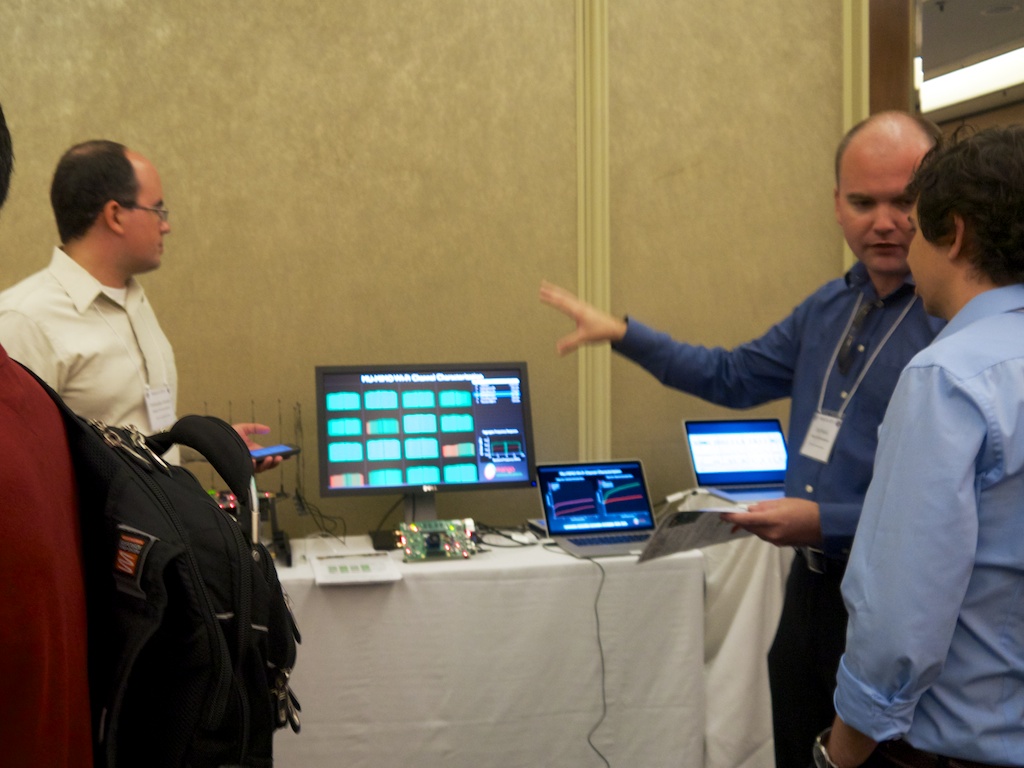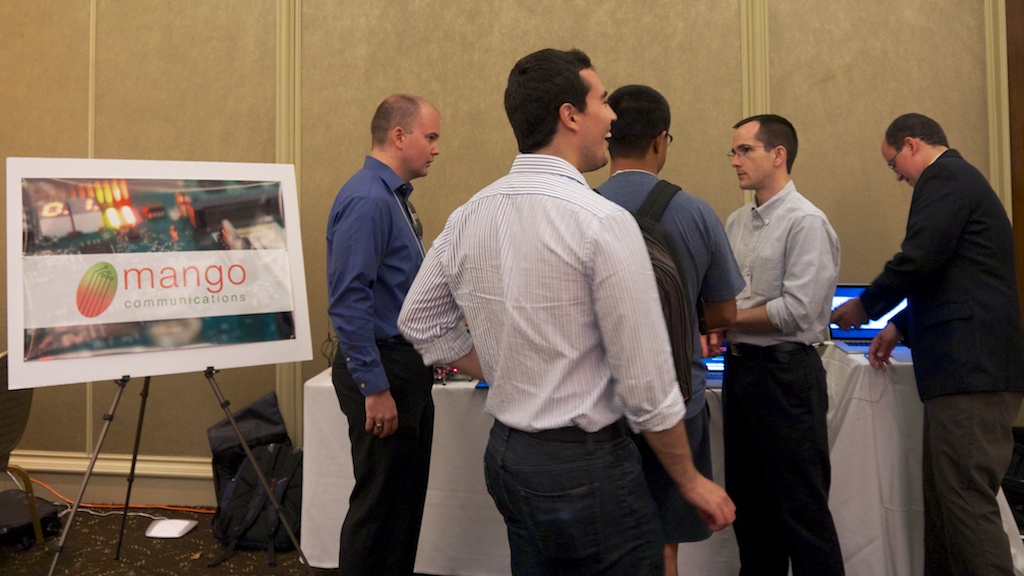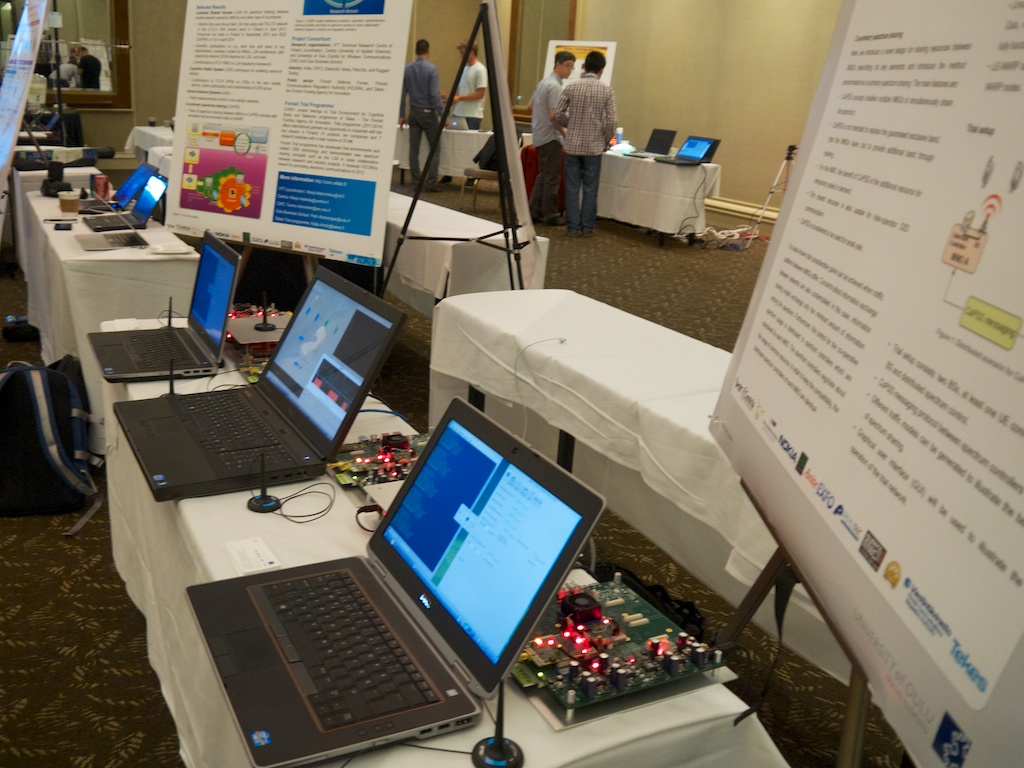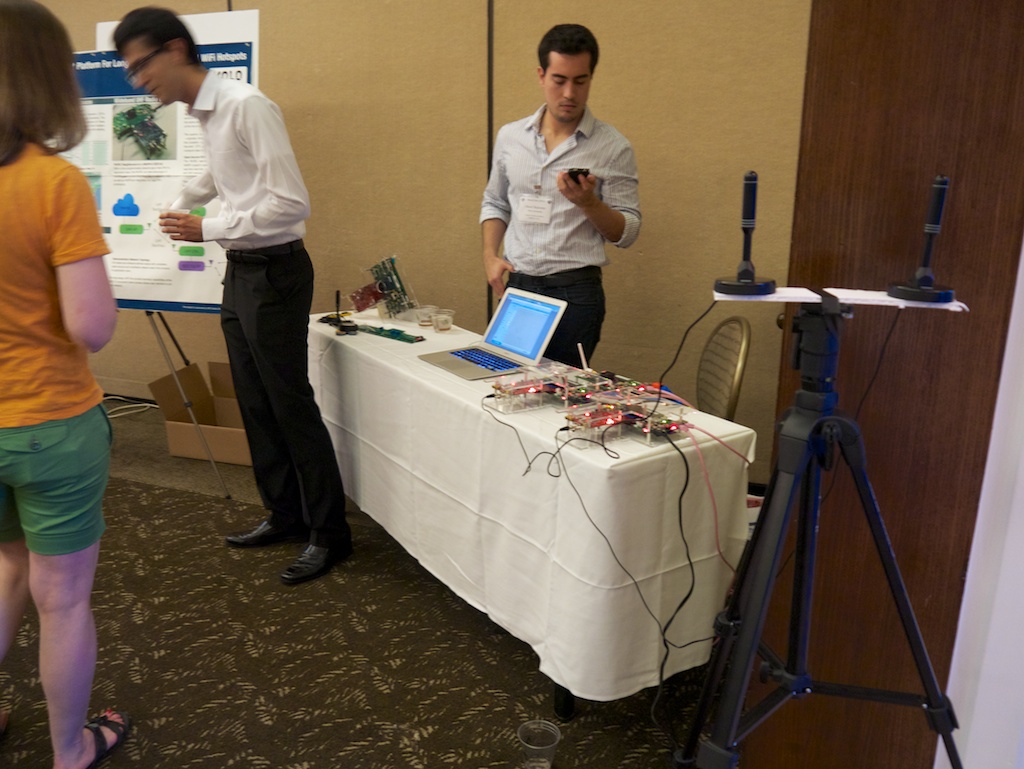Mango Communications Team Presents Demo at ACM MobiCom 2014
Mango Communications presented a demonstration titled Real-Time MU-MIMO Channel Analysis with a Custom 802.11 Implementation at MobiCom 2014. The demonstration combined WARP v3 with the 802.11 Reference Design to let conference attendees use their own Wi-Fi clients to interact with the hardware and witness real-time changes in MU-MIMO channels. This demonstration is one of the many research applications enabled by the Mango Communications 802.11 Reference Design, an open-source, real-time FPGA implementation of the 802.11a/g MAC and PHY.
Demonstration Details
The demonstration consists of 5 WARP v3 nodes running the Mango 802.11 Reference Design:
- 1 is a standard AP serving Internet access to Wi-Fi clients. This AP implementation is identical to the Access Point implementation part of the 802.11 Reference Design release.
- 4 are quad-antenna monitors capturing per-subcarrier channel estimates for real-time analysis.
Conference attendees join the open AP with their personal Wi-Fi clients (e.g. smartphones/tablets) and use the AP to access the Internet. Once the association process with the AP is complete, the 16-antenna array of WARP boards begins to overhear transmissions from the conference attendees' Wi-Fi clients. The OFDM Receiver in each array element's PHY automatically estimates the channel between the conference attendees' devices and itself. These channels are estimated via the two LTS symbols in the preamble of every transmission from the Wi-Fi clients. The array of WARP v3 boards then streams these channel estimates to a custom application for processing and visualization via the WLAN Experiments framework.
 | 
|
| (1) | (2) |
The custom application consumes the per-user, per-antenna, and per-subcarrier channel estimates and produces the two visualizations seen above.
(1) In the first window, the application displays a list of users on the right. For the selected user, the application plots the magnitude of each channel estimate between that user and the 16 array elements. Since this visualization occurs live, the user is able to move their Wi-Fi client around and see the impact of their mobility on the wireless multipath environment.
(2) In the second window, the large array of channel estimates is processed to determine the rate that a multi-user AP would be able to achieve if the given channel estimates accurately represent the wireless environment at the time that a MU-MIMO waveform could be sent. Specifically, 4 users are selected using the UI elements on the bottom of the window. Using a Moore-Penrose Pseudoinverse, MU-MIMO beamweights are calculated for the instantaneous snapshot of the complex-valued channel estimates (i.e. the zero-forcing MU-MIMO solution). Using these beamweights, the effective SNR to each user is calculated and the achievable rate for each user is determined using Shannon's classic log(1 + SNR). Depending on the instantaneous channels, this matrix may be near singular, thereby collapsing the MU-MIMO AP's ability to send each user an independent data stream. In the live demo, the users can witness this behavior in the rate calculation by moving their devices very close to one another. Furthermore, standard single-user beamforming achievable rates are also plotted for each user for comparison. With every additional antenna, single-user beamforming only has a logarithmic increase in achievable rate, so there are very diminishing returns with large antenna arrays. The promise of MU-MIMO is that the network rate than can be achieved can scale linearly with the number of users once a sufficient number of antennas is used.
There are many remaining challenges to building real MU-MIMO systems at scale. This demonstration shows how WARP and the 802.11 Reference Design can be used to study the fundamental channel characteristics that will impact the performance of MU-MIMO systems. Other WARP users (such as the Rice Argos project) are using WARP to go even further and actually build real MU-MIMO systems.
All code used in the demonstration corresponds to SVN revision 3852.
Conference handout: PDF (660 kB)
Video of Demonstration from MobiCom 2014
Photos from the Demo Floor

| |
 | 
|

| |
Other Demonstrations Featuring WARP
In addition to the Mango team, two other groups gave demonstrations built on top of WARP.
 | 
|
| (1) | (2) |
(1) Co-primary Spectrum Sharing with Inter-Operator D2D Trial - Markku Jokinen , Marko Mäkeläinen, Tuomo Hänninen (University of Oulu)
(2) An Open-Source Development Platform for Long-Range UHF-Connected WiFi Hotspots - Ryan E. Guerra, Narendra Anand, Edward W. Knightly (Rice University)
Attachments (9)
- mobicom_1.jpg (267.5 KB) - added by chunter 10 years ago.
- mobicom_2.jpg (342.1 KB) - added by chunter 10 years ago.
- mobicom_3.jpg (179.6 KB) - added by chunter 10 years ago.
- mobicom_4.jpg (195.1 KB) - added by chunter 10 years ago.
- mobicom_5.jpg (259.2 KB) - added by chunter 10 years ago.
- mobicom_6.jpg (236.3 KB) - added by chunter 10 years ago.
- Mango_MobiCom_2014_Handout.pdf (659.8 KB) - added by chunter 10 years ago.
- screenshot.png (280.7 KB) - added by chunter 10 years ago.
- screenshot2.png (313.9 KB) - added by chunter 10 years ago.